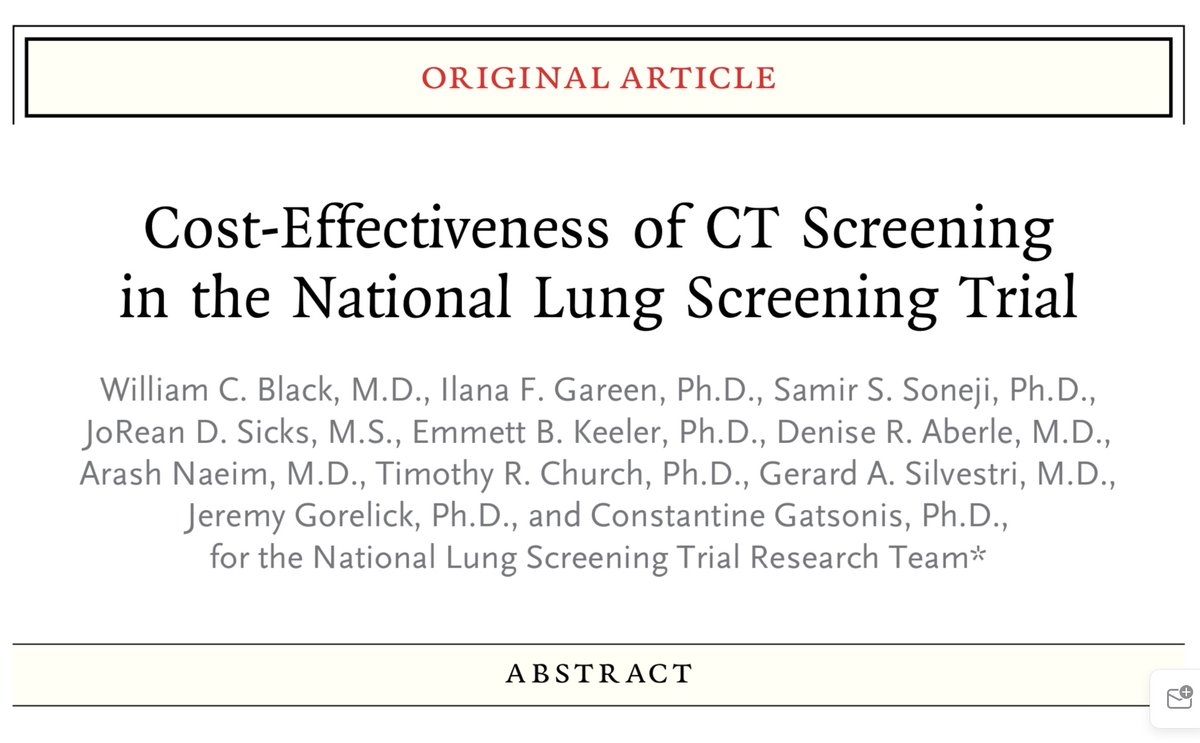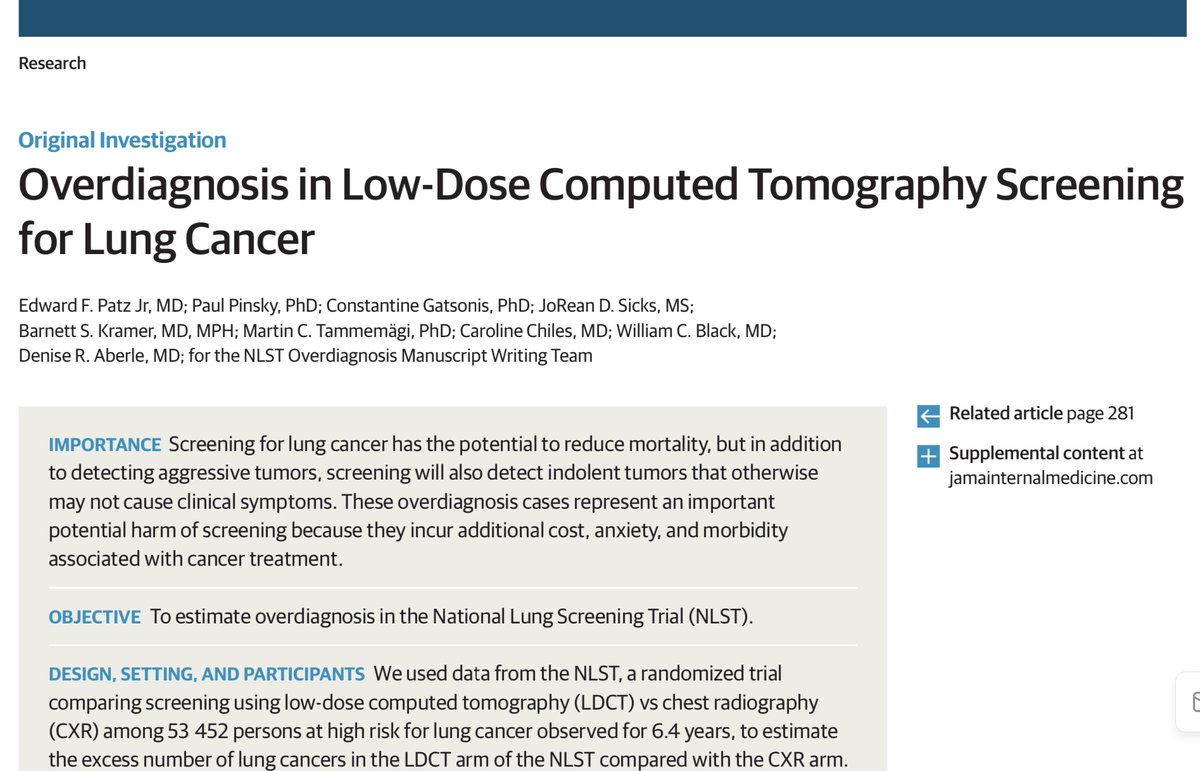
20 November: Screening part 1
This year for Lung Cancer Awareness Month #LCAM I’m going to summarize 30 important lung cancer trials over 30 days. These posts are directed at non-medical professionals, with descriptions of the results and of what makes a good trial. #lcsm 1/17
This year for Lung Cancer Awareness Month #LCAM I’m going to summarize 30 important lung cancer trials over 30 days. These posts are directed at non-medical professionals, with descriptions of the results and of what makes a good trial. #lcsm 1/17

I’m going to spend the next two days on screening studies. Honestly, I have some trepidation in posting on this topic. There are advocates of screening and sceptics about screening, both vocal, and I’m probably going to disagree with most of them. Let’s look at some evidence.2/17
I’m going to review two large screening studies: NLST and NELSON.
Screening is the testing of asymptomatic individuals at risk for a disease. An underlying assumption is that earlier detection results in better outcomes. For many cancers this seems to be the case. 3/17
Screening is the testing of asymptomatic individuals at risk for a disease. An underlying assumption is that earlier detection results in better outcomes. For many cancers this seems to be the case. 3/17
Compared to other cancer screening programs, there are some challenges for lung screening:
1. The test (CT scan) is relatively expensive (compared to pap smears, mammograms)
2. Non-cancer abnormalities (lung nodules) requiring additional testing are quite common
4/17
1. The test (CT scan) is relatively expensive (compared to pap smears, mammograms)
2. Non-cancer abnormalities (lung nodules) requiring additional testing are quite common
4/17
Both of these problems can be addressed by limiting screening to the people at highest risk of the disease. Practically, in a western population, this means people with a substantial smoking history. (there are studies in East Asian populations where smoking is less significant)
Of course it is the case that people who are non-smokers also get lung cancer. The challenges of screening for non-smokers will come out in the next two days' discussion. 6/17
The National Lung Screening Trial (NLST) was a very large study, enrolling 53 454 people in the United States in 2002-2004. They were:
1. 55-74 years of age
2. 30 pack years smoking history (packs per day x years smoked = pack years)
3. If quit, the quit date was <15 years ago
1. 55-74 years of age
2. 30 pack years smoking history (packs per day x years smoked = pack years)
3. If quit, the quit date was <15 years ago
They were randomized to either CT scans at baseline, one year, and two years, or to chest x-rays at the same intervals. Primary outcome was lung cancer mortality, with numerous secondary endpoints. Median duration of follow up after enrollment was 6.5 years. 8/17
The top-line result is that there was a 20% reduction in lung cancer death (95% CI 6.8%-26.7% p=0.004). Critically, there was also an all-cause mortality benefit, with the rate of death form any cause reduced by 6.7% (95% CI 1.2-13.6% p=0.02). 9/17 

These are relative reductions; we also know the absolute numbers:
1. There were 87 fewer lung cancer deaths in the screening group (356 vs 443).
2. The number of cancers diagnosed in the x-ray arm was 941, compared to 1060 in the screening arm (difference of 119).
10/17
1. There were 87 fewer lung cancer deaths in the screening group (356 vs 443).
2. The number of cancers diagnosed in the x-ray arm was 941, compared to 1060 in the screening arm (difference of 119).
10/17
The cost-effectiveness of this screening program (in 2014) was $52 000 per life-year gained (95% CI $34 000-$106 000).
This is attainable in the world’s wealthiest economies, but is at the outer edge of what would be considered cost-effective care. 11/17
This is attainable in the world’s wealthiest economies, but is at the outer edge of what would be considered cost-effective care. 11/17

There is a vast secondary literature around this study, and we could discuss many issues. I would like to introduce the idea of overdiagnosis.
Overdiagnosis is the diagnosis of a cancer that, if not diagnosed, would not have become symptomatic during that person’s life. 12/17
Overdiagnosis is the diagnosis of a cancer that, if not diagnosed, would not have become symptomatic during that person’s life. 12/17
Overdiagnosis is distinct from a false positive: this would be a test that diagnosed cancer when no cancer was present.
Overdiagnosed tumours are true cancers that will not progress to cause symptoms during a person’s life.
13/17
Overdiagnosed tumours are true cancers that will not progress to cause symptoms during a person’s life.
13/17
We know from series of autopsies of people who have died of non-cancer causes that substantial numbers of us are walking around with small asymptomatic cancers that may not bother us during our lives. Perhaps not a comforting thought, but true!
14/17
14/17
Rates of such indolent cancers can be inferred from the excess cancers diagnosed in NLST.
Presumably (because of randomization) both arms have the same number of cancers, but 119 fewer were diagnosed without screening. Those cancers have not become evident in years of followup.
Presumably (because of randomization) both arms have the same number of cancers, but 119 fewer were diagnosed without screening. Those cancers have not become evident in years of followup.
We do not know which particular cancers are overdiagnosed, so patients go through surgery or radiotherapy, and possibly chemo treatments
The proportion of overdiagnosed cancers in NLST has been estimated as high as 18%, though likely closer to 9%. (declines with longer followup)
The proportion of overdiagnosed cancers in NLST has been estimated as high as 18%, though likely closer to 9%. (declines with longer followup)

This is not the last word on screening by any means. Come back tomorrow when we’ll talk about the NELSON study, and the difficulty of “Lung Cancer Mortality” as a primary endpoint. 17/17 

• • •
Missing some Tweet in this thread? You can try to
force a refresh












